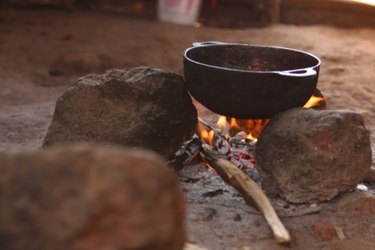
Cast iron is used in a range of applications, from durable cookware to architectural elements to automotive components. Among the benefits of cast iron, particularly when used in cooking, are its favorable thermal properties. The thermal properties of cast iron allow it to evenly distribute and retain heat over a long period of time, making it a popular option for frying pans and stock pots. Its high melting point makes it useful for more extreme industrial conditions.
Thermal Conductivity
Video of the Day
Thermal conductivity refers to the ability of a material to transfer heat energy. A material that has high thermal conductivity will increase in temperature over a large area in relatively little time. The thermal conductivity of cast iron is 27 to 46 British thermal units (or BTUs) per hour-feet-degrees Fahrenheit. One British thermal unit is equivalent to the heat necessary to raise 1 pound of water by 1 degree Fahrenheit. In other words, the cast iron transfers between 27 and 46 BTU of heat over 1 foot in one hour. By comparison, aluminum has a conductivity of 118 Btu/hr-ft-F; copper has a conductivity of 223 Btu/hr-ft-F.
Video of the Day
Heat Capacity
Cast iron's high heat capacity means that it can maintain a relatively high heat, evenly and steadily over time. In kitchen applications, this means that pouring a large quantity of cool liquid into a cast iron pot won't change the pot's temperature too quickly. In addition, when searing a piece of meat on a cast iron pan, you'll find even browning, as the heat is evenly distributed around the pan's surface. Heat capacity is measured in terms of the energy necessary to transmit heat throughout a given mass of material. Cast iron's specific heat capacity is 0.00013 Btu/lbs-F, slightly lower than that of cast steel. When analyzed for its use in industrial or construction purposes, cast iron's heat capacity is relatively low, compared with reinforced concrete, with a heat capacity of 0.0002 Btu/lbs-F, or silica fire bricks, with a heat capacity of 0.00024.
Melting Point
The melting point of cast iron averages 2,150 to 2,360 degrees Fahrenheit. The melting point, itself, rarely comes into relevance under general circumstances. It is used, however, to determine some of the metal's other thermal properties, such as its heat storage capacity, a reflection of the material's melting point, density and heat capacity. Compared with aluminum's melting point, of 1,220 degrees Fahrenheit, or copper, which melts at 1,983 degrees Fahrenheit, cast iron melts at an extremely high temperature.
- Apartment Therapy: How to Shop for Cast Iron Cookware
- Automedia.com: Affordable Exhaust Manifold Swap
- Engineering Toolbox: Thermal Conductivity of Metals
- Engineering Toolbox: Units of Heat- BTU, Calorie and Joule
- Wired: The Only Five Kitchen Tools You Really Need
- UnitConversion.org: Specific Heat Capacity Converter
- National Renewable Energy Laboratory: Survey of Thermal Storage for Parabolic Trough Power Plants
- Engineering Toolbox: Heat Storage in Materials
- Engineering Toolbox: Metals - Melting Temperatures